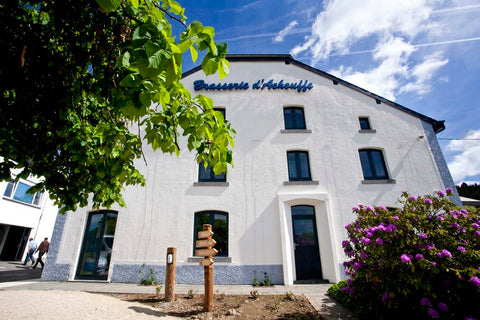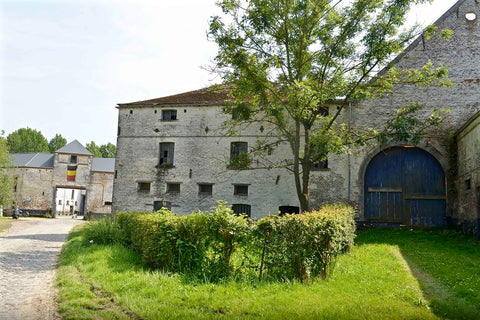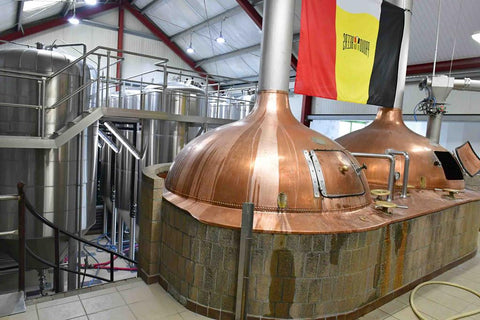- No products in the cart.
Bières de Chimay

The Beginning – Chimay may be the name of the beer. But the abbey itself – founded by this renowned community of Trappists – is actually called Scourmont Abbey. It dates from 1850, a time when a few hardy Trappist monks from Westvleteren Abbey were looking for a new challenge. The remote Scourmount plateau, in Hainaut, seemed the ideal locale. Seventeen monks from Westvleteren arrived here that year, and began cultivating a stony plot of land, donated by local Prince Joseph de Chimay.
It was work only fit for those of a pioneering spirit. From an area of 2.5 hectares, no less than 2,600 cubic metres of stone were dug out of the soil. All that hard work paid off, though – the abbey was initially sustained by the proceeds of agriculture, won from that unpromising soil. They were even able to set up a dairy here in 1872.
At first the monks purchased their refectory beer from the local breweries, but self-sufficiency in all matters was important to these followers of the Benedectine way So by 1862, Chimay abbey had started brewing beer, initially for the monks’ own use only. The first brew was a described as a ‘double Bock beer, Bayern style’. But they didn't rest there. A high-fermentation dark beer, inspired by the produce of Westvleteren, soon followed, laying down the first page of a what was to become a brewing legend.
That's because this dark brew was the predecessor of the current Chimay Rouge, the first of Chimay's much mythologised (and colour-coded) threesome. They were the beers that put the Trappists on the world map of beer.
Unlike most other Trappists, the monks of Chimay didn't shy away from promoting their brews. For example, they encouraged ‘the friends of the house’ to spread the word about their new beer. Naturally, the superior quality of the abbey's beers was always their first concern – and also a big selling point. Numerous analyses were referenced which demonstrated that the beer was ‘hygienic, extremely nourishing and free from chemical substances and low-quality ingredients’.
At one point Chimay was even prescribed by the local GP. The first, small-scale brewery producing these 'medicinal' beers was, sadly, completely destroyed during the Second World War.
A fresh start was called for, post-war, and the Brothers decided to re-establish the brewery using the latest technology. Brother Théodore developed a new strain of yeast, and then the Chimay Bleu saw the light in 1948.
This was meant to be a Christmas beer, but it was so successful that it was soon produced all the year around. It was given the name of ‘Grande Réserve’, as this is an excellent beer for laying down, or building up a ‘réserve’. As a result, just as with a grand cru, the vintage is displayed prominently on the label. Consequently (although it was certainly unintended) Chimay found itself contributing to the current craze for ‘old beers’ – letting time work its magic on brews that store well.
To complete the troika of original Chimay brews, the Chimay Blanc tripel was added to the range in 1966. The Principality of Chimay enjoyed its 500th anniversary in 1986, and to celebrate the occasion, the tripel was bottled in a 75cl-format, and given the name ‘Cinq Cents’.
Chimay is, however, now also brewing a fourth beer, the light Chimay Dorée, a rather special beer served exclusively in the abbey, and its associated inn, l’Auberge de Poteaupré. So what is that makes all that comes from Chimay so special? Well, as you might expect, the answers all lie in the manner of the brew.
The Brewing

The distinctive Chimay brewing process starts with the mineral water that's used for brewing – and its own home-grown yeast strain. Ever since the brewery was relaunched in 1948, this strain has been used for all of its beers. It is used both for the main fermentation, as well as to start up the re-fermentation, just before bottling. All the Chimay beers spend three weeks re-fermenting in the brewery's warm room.
But let's rewind. Where does the Chimay brewing process actually begin? It all starts with a 'maischen': a mixture of water and roughly mashed malts.
This is added to the mashing kettle, and heated-up through various stages. The aim is to free the sugars that will be converted into alcohol by the yeast. After this ‘maischen’ process , the wort and the chaff are separated using a large pressure filter. Next up is the wort boiling. During this process, the brewer will add two doses of hops, both at the beginning and at end of the boiling, in order to obtain the required level of bitterness.
The wort is then cleared (filtered), and cooled down in the centrifuge. It will then be transported to the fermentation tanks, where that very specific Chimay yeast is brought to bear – and starts its work of turning sugars into alcohol and carbon dioxide. All Chimay beers are high fermentation beers: that is, they will ferment at a higher temperature – of between 18 and 32 °C – which allows the yeast to rise to the surface.
After three to five days, depending on the type of beer, the brew is filtered again in the centrifuge, before being set aside for a cold maturing, for two weeks. The low temperature in the storage tanks certainly adds to the beer’s stability. But it does make it more cloudy; so the beer is filtered once again.
It is then ready to be pumped into the lorries, to be transported to the bottling plant. At the same time, a generous dose of liquid sugars and fresh yeast is added. These are all the ingredients that are needed to ensure a lively re-ferment of the beer in the bottle.
The Brewers

When Brother Théodore entered the order, at the tender age of 19 in the year 1932, he was somewhat unprepared for a career in brewing. "Little did he know.." as they say "..and he knew rather little". The young theologue therefore sought advice and assistance from the eminent Professor Jean Declerck, of the Hogere Brouwerijschool (or Higher Institute for Brewing) in Leuven.
Brother Théodore would later attend the same Institute, and himself graduate as a brewing engineer. He worked with the Professor to determine the new course the Chimay brewery should follow. And with a patience that only monks have, Brother Théodore ended up isolating and selecting the yeast culture that, to this day, forms the basis for all Chimay beers.
This yeast is pretty special, becoming active at a high temperature, and it gives the beer its characteristically herbal and peppery touch. All this yeast-questing took some two years of research. And Brother Théodore’s recipes have since remained unaltered. Some critical voices, though, have claimed that the ingredients have in fact changed, in the intervening years. But this is something that the abbey denies in the strongest possible way.
What is certain is that all the ingredients have been listed on the label, with no deviation, since 1990. And that 'candy sugar' has been banned for at least forty years. Instead, the brewery uses dextrose for the main fermentation – and inverted sugar-syrup to start off the re- fermentation in the bottle.
So states Marcel Gobeaux, the man who has been Chimay’s main brewer for over twenty years. He believes that the yeast is the main contributor to the beers’ typical character, or aromas. Malt extracts are added sparingly, mainly to provide a consistent colour, as the colour intensity from the pale and caramel malts may differ.
He believes that if there are any differences in colour, they have nothing to do with changes in the recipe. Rather, they can be put down to a yeast that has adjusted to its environment. For example, these days the beer will generally ferment in the tanks for four to six days. But in the past the main fermentation took somewhat longer.
The Beers
The Visit

Seclusion is paramount for the monks of Chimay. So the abbey, the brewery and the dairy are all closed to visitors. However, you will definitely receive a warm welcome in the adjacent Espace Chimay complex. It has a fine inn – in the shape of the Auberge de Poteaupré – a well-stocked shop selling everything 'Chimay', a hotel and an interactive visitors centre – the Chimay Expérience.
And while a charge is levied to enter, a free tasting of the Chimay Dorée is included in the entrance fee. The Espace Chimay displays pretty much everything you could ever wanted to know about the abbey, its beers and its cheeses. A visit starts off with a welcome in around hundred different languages – this is a site of international pilgrimage, after all. You enter through a glass-walled corridor at the front of l’Auberge de Poteaupré, a stylish but sober inn, very much in keeping with the Trappist spirit. Many a visitor's eye, however, is caught immediately by Chimay's recently refurbished store.
Here, you can purchase well-nigh all of Chimay Abbey's products, from beer to cheese to merchandise. The museum entrance displays a huge map of the world, created from empty Chimay tasting glasses. Tucked away tidily underneath the bell jars, you'll find various kinds of drinking glasses on display, each testifying to their own beer tradition.
Interactive screens evoke (and explain) the brewing process, as well as how the abbey cheeses are made. Information displays also cover the wider Chimay area, and its natural world, helping to round off the exhibition.
After which, of course, it's tempting to step out to explore, on one of the surrounding trails. Two such walks depart from the Auberge de Poteaupré. First there is the eponymous ‘Poteaupré’ walk (4.7 km), which takes you past the Ferme de Poteaupré, Ruisseau des Baraques and Ferme du Prince. The second, and longer, walk is ‘Haute-Grange’.
It is 8.1km long, and also takes you past the Ferme de Poteaupré, before heading to Bourlers wood, Saint-Rolande Chapel, then on to the Haute Grange Bois de Thiérache, via the Ferme du Prince.
But don't forget that free glass before you leave – a visit would here wouldn't be complete without a tasting of the Chimay Dorée, which is only available on tap here at the Auberge de Poteaupré.
The Location

The history of the Principality of Chimay winds back at least as far as the 12th century. You can readily embrace its full medieval character simply by taking a walk down the streets of this tiny town. Try following the path along the ancient city walls, or ascending the steps that take you to its fascinating old laundry and baths.
The Castle of the Princes, built on a rocky outcrop above the Eau Blanche River, lends Chimay its dignified air, as does the dome-shaped bell tower of the collegial church of Saints-Pierre-et-Paul.
Down through the ages, the seemingly irreducible Princes’ Castle has been destroyed or burned down no fewer than seven times. Each time, however, it has managed to rise from the ashes. This impressive castle, parts of it dating back to the 15th-century, is built in the style of Henri IV. Its chapel is well worth a visit; so too, are its long hallway, portrait gallery, sentinels’ hall and theatre. The castle theatre was established in 1863 by Prince Joseph II, the very same noble who also helped found Scourmont Abbey.
The Chimay region – part of the Botte du Hainaut – also includes a scattering of picturesque villages, found hugging the area's small rivers, or nestled at the bottom of its rocky outcrops. Here you will come across ancient farm houses, smithies where iron is forged on-site, churches and rural chapels, fountains and bygone communal laundries.
Nature-lovers will find much to their liking in this region, too. The Oise, which has its spring quite near Scourmont Abbey, wends its way across the widely varying landscapes. This part of Hainaut is also well-forested, and is criss-crossed by plenty of walking trails.
There is also a fascinating story to be told at the nearby lake of Virelles. The museum to be found here, which is actually part of the lake, allows you to take a (thankfully dry) dip into its waters. Cameras have been installed on the site, both in the lake and surrounding it, including nearby nesting boxes. The aquatic animals peer back at you from behind large screens, so you can follow their lives throughout the seasons.
At weekends (and during school holidays) a nature guide will be on-hand to explain the secrets of the lake to you. You can also take a leap back in time and discover the turbulent history of this lake over 500 years.
Ready for a walkabout? There's a lakeside route that gives you a chance to study it close-up, from below the lake's surface, at the lake margins, or even from the top of nearby trees. There are also many enchanting walks departing from this nature reserve, too. All in all, Chimay makes for an excellent destination if you want that 'great outdoors' experience.
Is there anything else worth visiting in this region? Yes, and plenty of it, as they are fond of saying here. Lompret is generally considered one of the most beautiful villages in Wallonia; Rance is host to the Marble Museum; Mariemont is the point of departure (and arrival) for a trip on the steam train through the Viroinval towards Treignes. In brief, the Botte du Hainaut is an undiscovered part of Belgium that offers unsuspected riches to tourists. Great for those who prefer their paths to be none too well-trod.
Getting There & Around
Chimay is situated in the province of Hainaut (or Henegouwen) just one hour’s drive from both Charleroi and Bergen (Mons) in the Namen (Namur) province. From the Charleroi direction, take the Philippeville - Couvin route (the N5), before heading onto Chimay via the N99. From the direction of Beaumont, you can simple follow the N53 (Rance - Chimay) road. By train, take the Charleroi to Sud-Couvin line, alighting at Couvin. And if you're travelling by bus, once again you'll find Charleroi is your best launchpad – look out for route 109 from Charleroi to Chimay.
Gastronomy, Food & More Beer

Pairing different gastronomic products is an art that Chimay mastered a long time ago. For example, the Poteaupré cheese has found its ideal partner in the Chimay Rouge beer, while the Vieux Chimay cheese makes for an excellent match to the Cuvée 150. That's one of the abbey beers was created specially to celebrate its 150th anniversary, in 2012.
That beer-plus-cheese pairing is taken to its ultimate conclusion in the Chimay à la Bleue. This cheese, only introduced recently, is rinsed in the abbey's beer during maturation. It results in a cheese with a perfectly balanced, ‘beery’ malt and yeast flavour.
This medley of tastes comes across the strongest in the 100% natural (and edible) crust of this Chimay cheese. It is this crust that comes into contact with the beer, and so retains most of the Chimay Bleu aromas.
In addition to beer and cheese, the Chimay region offers several other specialities. One it is perhaps most proud of is 'escaveche'. This is eel or trout pickled in vinegar (or as the Flemmish would say, ‘in ’t zuur’). Each local restaurant has its own recipe, which could use smoked or freshly-baked fish, steeped with a gelatinous or runny sauce.
The fish used in 'escaveche' is slow-cooked in the oven, after having been marinated in fish stock and vinegar, and it's then seasoned with lemon and herbs. An 'escaveche' is usually accompanied by French fries or a baked potato.
A great place to try this regional recipe is at L’Eau Blanche, in the village of Lompret. Even better, enjoy it with a freshly poured Chimay Blanche.
More Info
Tourist information for Chimay:
VVV Chimay Promotion
Rue du Château 14
B-6460 Chimay
Tel: +32 (0) 60/ 21 54 04
Website: www.chimaypromotion.be
Email: info@chimaypromotion.be
Tourist information for Hainaut/Henegouwen province:
Toerisme Henegouwen
Rue des Clercs 31
B- 7000 Bergen
Tel.: +32 (0) 65/ 36 04 64
Website: www.hainauttourisme.be
Contact
.jpg?1392386956)
Espace Chimay
Rue de Poteaupré 5
Rue de Poteaupré 5
B-6464 Bourlers








